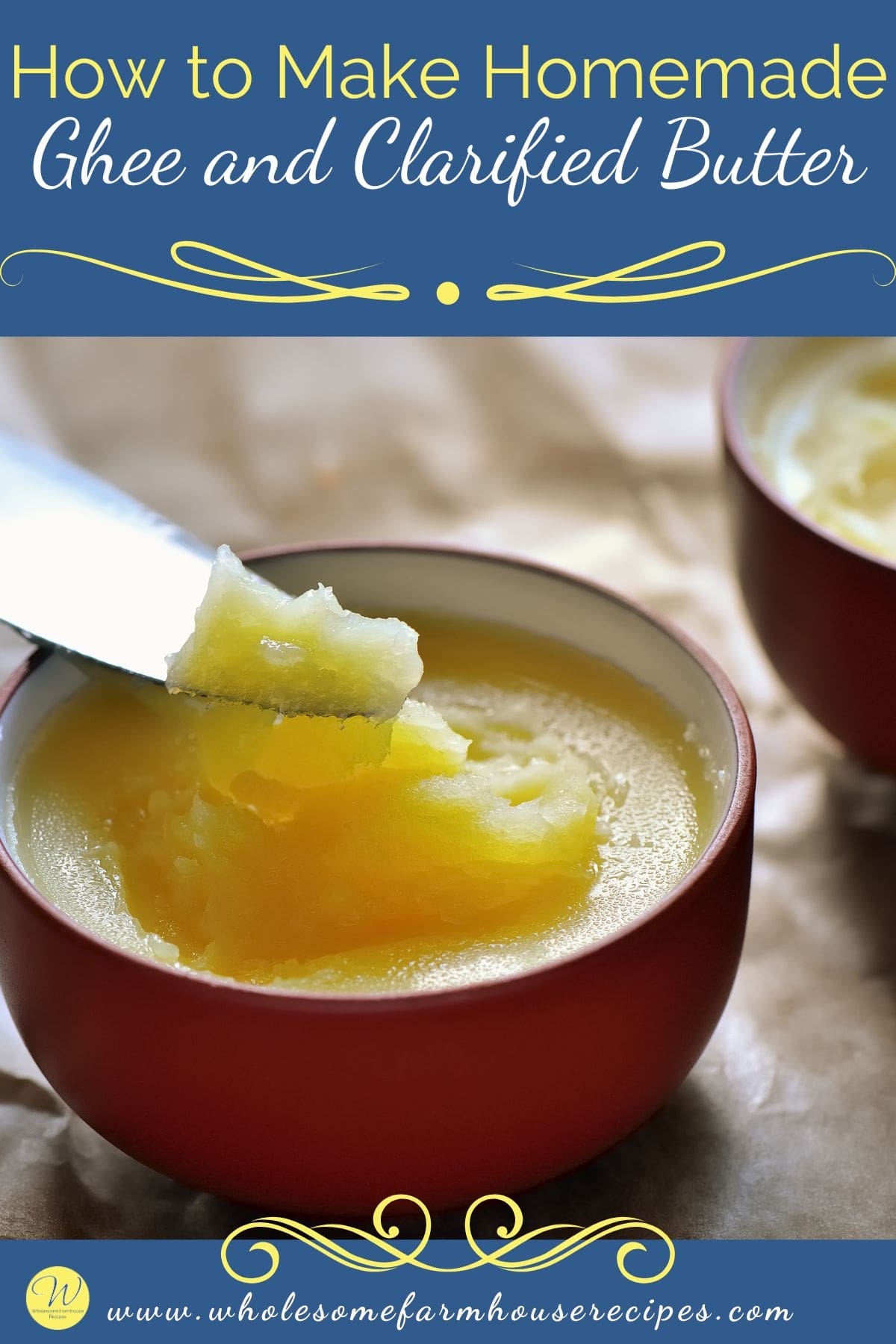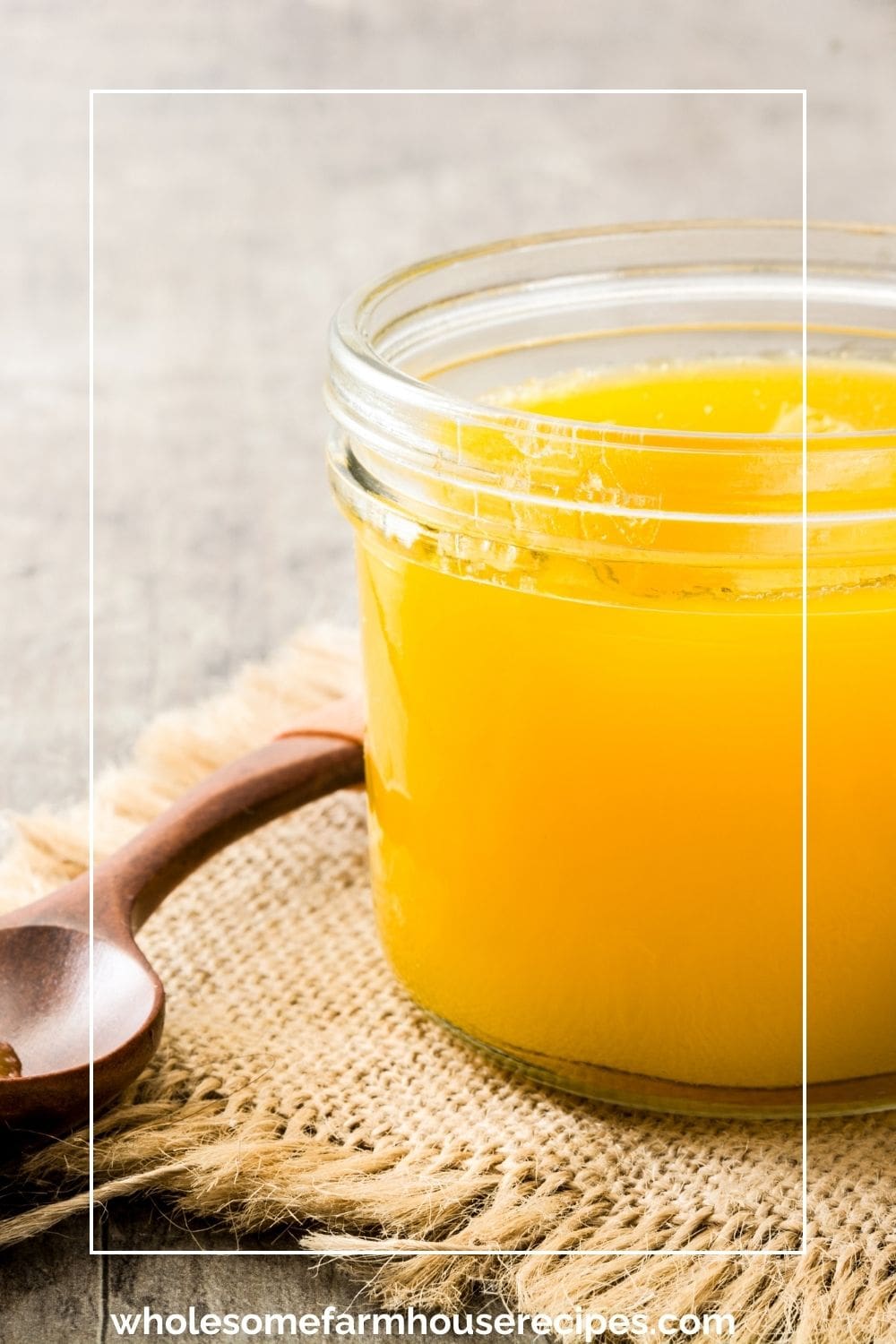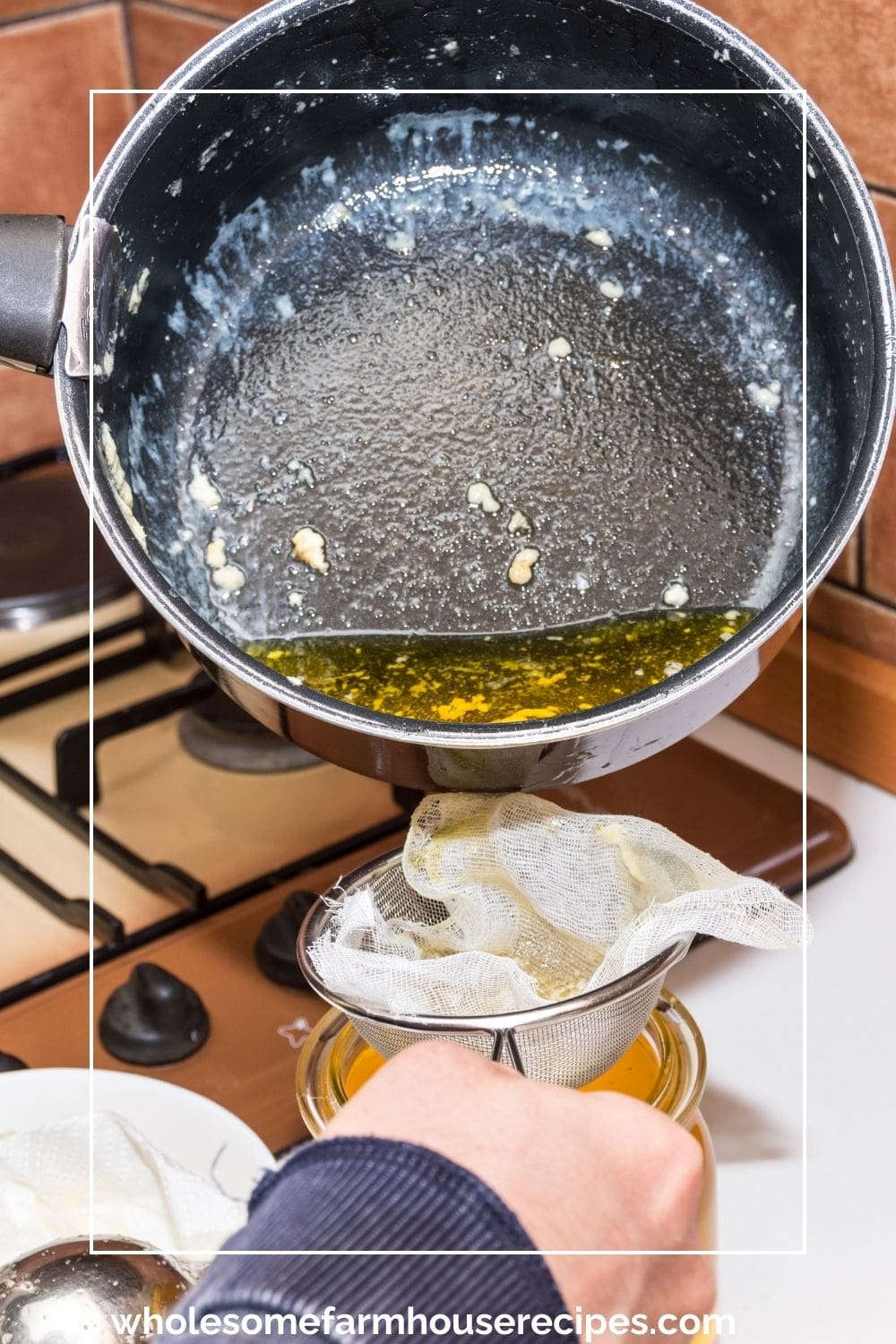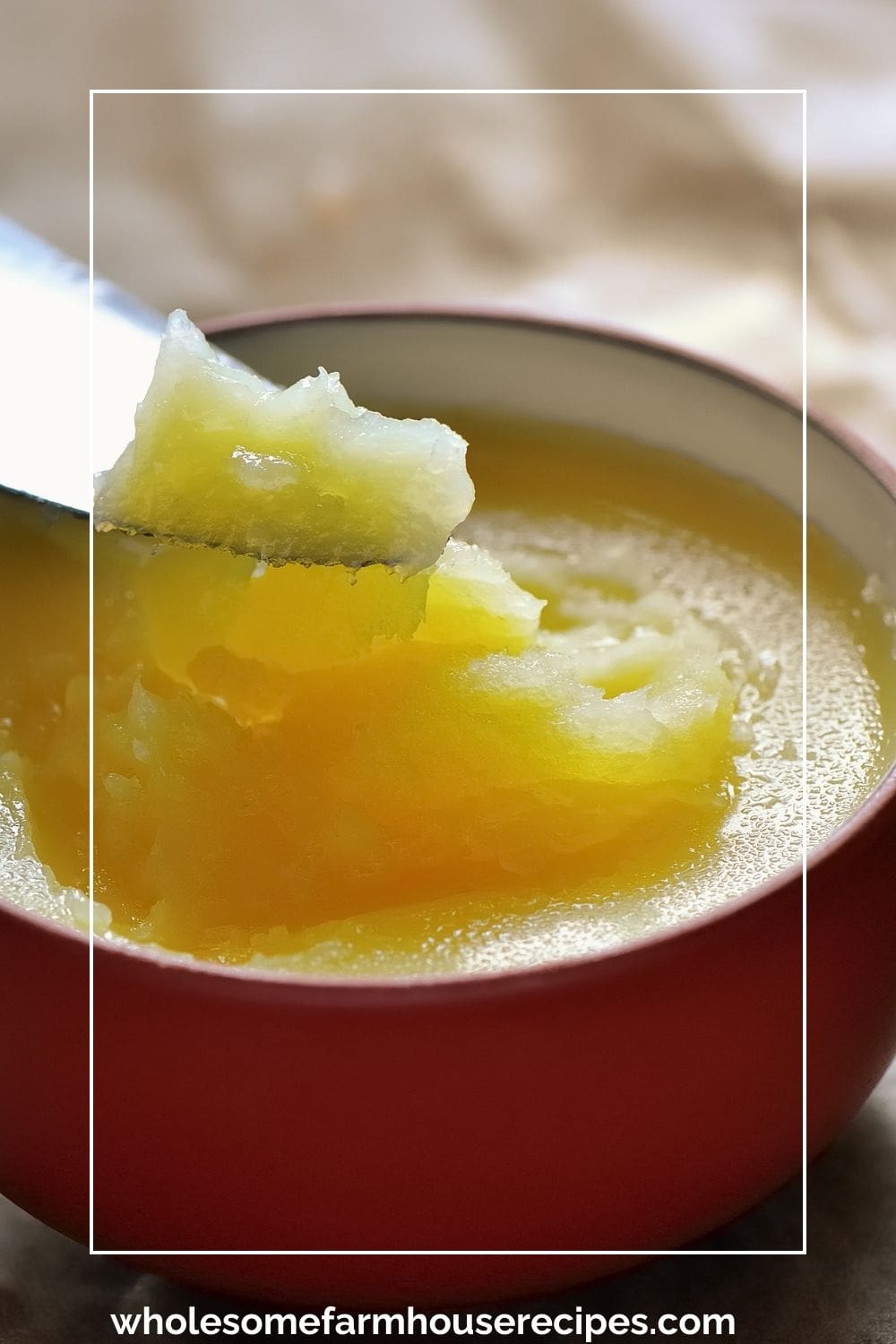Learn how easy it is to make Homemade Ghee and Clarified Butter. Two close cousins in the realm of culinary fats (I’ll elaborate on their nuances shortly). They’re simple to prepare, cost-effective compared to store-bought options. They boast a long shelf life, and offer a high smoke point, making them ideal for high-temperature cooking methods.. Like pan frying or roasting without the risk of burning, a common pitfall with regular butter.
The best part, taking the few minutes to make your own ghee and clarified butter is so much cheaper than store-bought ghee. It’s such a versatile ingredient and the golden color is so enticing.
These fats are used prominently in various culinary traditions, such as in the intense buttery richness of many traditional Indian curries. The crisp perfection of dishes like Potato Rosti when pan fried, and even as a secret weapon in whipping up luxuriously smooth Hollandaise Sauce.

Make it in the Microwave or on the Stovetop
We have instructions for making your own ghee and clarified butter using different methods. You can make both ghee and clarified butter in the microwave. It’s slightly different from the traditional way of using the stovetop.
Clarified butter vs ghee
Wondering about what is clarified butter and ghee? Let me help explain.
Clarified Butter is essentially butter stripped of its dairy components and water, leaving behind pure butter fat. Ghee, a variety of clarified butter, its preparation method ensures the complete removal of dairy solids, unlike some basic clarified butter techniques.
- Both boast a richer butter flavor (sometimes called liquid gold).
- Ghee has a delightful nutty flavor from its browned butter as the milk solids brown from the longer cooking time.
- They are both a radiant golden yellow hue, free from any cloudy residue or foam typical of melted butter. Because it no longer has any milk proteins.
- These culinary gems elevate dishes to crispy perfection.
- Moreover, their high smoke point, reaching up to 230°C/450°F compared to butter’s meager 175°C/350°F, means you can confidently fry and sauté at higher temperatures without triggering a smoke alarm unlike using vegetable oils.
Drawn butter vs clarified butter
You might be wondering if they are the same thing. Drawn butter and clarified butter are often confused, but they have some differences.
Drawn butter is simply melted butter that hasn’t been clarified. This means that while it’s liquid, it still contains the milk solids and water found in regular butter. Drawn butter is often served as a dipping sauce for seafood dishes like lobster or crab.
On the other hand, clarified butter is butter that has been melted and then cooked to separate the milk solids and water from the pure butterfat. This process removes impurities and allows the butter to have a higher smoke point. Making it ideal for cooking at high temperatures without burning.
In summary, drawn butter is melted butter in its natural state. While clarified butter is melted butter that has been purified by removing the milk solids and water.

Recipe Tips for Success
Quality Butter. Use high-quality unsalted butter for the best flavor and results.
Low Heat. Maintain a low to medium-low heat throughout the process to prevent the butter from burning. If you have the time, it is best to use the lowest setting to avoid any burning. You can also use a heavy-bottom saucepan to help prevent burning.
Skim off the foam as it appears to ensure a clear and pure ghee.
When using the microwave method, it’s crucial to monitor the butter closely to prevent overheating or boiling over. Additionally, microwaves vary in power, so you may need to adjust the cooking time accordingly. Be cautious when handling hot containers and melted butter to avoid burns.
How to Make Homemade Ghee and Clarified Butter
As an Amazon Associate I earn from qualifying purchases.
Kitchen Essentials
Ingredients
- 1 Pound Unsalted Butter it can be homemade butter, store bought, organic butter, or grass-fed butter
- Salted or unsalted will work though some insist that the best ghee is made with unsalted butter. I’ve used both. (Use any amount you desire. This recipe works well with any quantity of butter.)
Instructions
Stovetop Ghee
- Cut the butter into small cubes or slices. This helps it melt more evenly.1 Pound Unsalted Butter, Salted or unsalted will work
- Place the butter in a heavy-bottomed pan or pot over medium heat.
- Allow the butter to melt completely and come to a gentle boil.
- Once boiling, reduce the heat to medium-low to maintain a gentle simmer. Stir the butter gently from time to time using a wooden spoon or spatula. This helps distribute the heat evenly and prevents any milk solids from sticking to the bottom of the pan.
- Continue simmering the butter until it starts to foam on the surface. The foam is whey proteins and will gradually dissipate, and you’ll notice the milk solids separating, breaking into smaller pieces, and sinking to the bottom of the pot. Cook until the color change, as it looks like brown butter in the milk solids. This is what gives it the nutty taste.
- Skim off any remaining foam on the surface using a spoon or ladle. This helps clarify the ghee further.
- Carefully pour the clarified butter (ghee) through a fine-mesh sieve or cheesecloth-lined strainer or coffee filter into a clean, dry container to remove the browned solids. Discard the milk solids or save them for other culinary uses if desired.
- Allow the ghee to cool to room temperature before sealing the container tightly.
Making Clarified Butter
- This method the same for making clarified butter
- The method for making clarified butter is essentially the same as making ghee. The main difference is that ghee is cooked for a longer period, allowing the milk solids to brown slightly, which gives it a nuttier flavor and aroma. Clarified butter is typically cooked for a shorter time, resulting in a milder flavor profile. Both processes involve melting butter, simmering it to separate the milk solids, and then straining the clarified liquid.
Microwave Method for Making Ghee
- Place the unsalted butter in a microwave-safe bowl. It’s essential to use a bowl with enough space to prevent overflow during melting.
- Microwave the butter on high power in short intervals, typically 30 seconds to 1 minute at a time, depending on the quantity of butter. Keep a close eye on it to prevent boiling over.
- After each interval, carefully remove the bowl from the microwave and check the butter. You may notice foaming on the surface, which is normal.
- Stir the butter gently to distribute the heat evenly and help the milk solids settle at the bottom of the bowl.
- Continue microwaving and stirring in short intervals until the butter has completely melted, and the white solids have separated and settled at the bottom. See the notes section for the suggested microwaving times. Once done, I like to pour mine into glass jars so I can see were the pure fat has separated from the solids.
- Once clarified, carefully pour the liquid butterfat (ghee) into a clean, dry container, leaving behind the milk solids in the bottom of the bowl. You may choose to strain the ghee through a fine-mesh strainer or cheesecloth to remove any remaining solids.
- Allow the ghee to cool completely before sealing the container and storing it at room temperature or in the refrigerator.
Microwave Method for Making Clarified Butter
- The process for making clarified butter in the microwave is similar to making ghee. Follow the same steps outlined above, adjusting the cooking time as needed based on your preference for flavor and color.
- The total microwaving time for making ghee or clarified butter can vary depending on factors such as the quantity of butter being melted, the power of your microwave, and your desired level of clarification. However, as a general guideline:
- For smaller quantities (e.g., 1/2 to 1 cup of butter), total microwaving time may range from 2 to 5 minutes, with intervals of 30 seconds to 1 minute each.
- For larger quantities (e.g., 1 to 2 cups of butter), total microwaving time may range from 5 to 10 minutes, with intervals of 1 to 2 minutes each.
- Keep an eye on the butter for signs of boiling over or burning, and stir it gently between intervals to ensure even heating and separation of milk solids. Once the butter is fully melted, clarified, and the milk solids have settled, you can proceed with straining and storing the ghee or clarified butter as desired.
Your Own Private Notes
Notes
How to Store Ghee and Clarified Butter?
Store the cooled ghee or clarified butter in an airtight container at room temperature or in the refrigerator for long-term storage.Nutrition

Microwave Method for Making Clarified Butter:
The process for making clarified butter in the microwave is similar to making ghee. Follow the same steps outlined above, adjusting the cooking time as needed based on your preference for flavor and color.
How long total does the ghee and clarified butter need to be microwaved?
The total microwaving time for making ghee or clarified butter can vary. It depends on factors such as the quantity of butter being melted, the power of your microwave, and your desired level of clarification. However, as a general guideline:
- For smaller quantities (e.g., 1/2 to 1 cup of butter), total microwaving time may range from 2 to 5 minutes, with intervals of 30 seconds to 1 minute each.
- For larger quantities (e.g., 1 to 2 cups of butter), total microwaving time may range from 5 to 10 minutes, with intervals of 1 to 2 minutes each.
Keep an eye on the butter for signs of boiling over or burning. Stir it gently between intervals to ensure even heating and separation of milk solids. Once the butter is fully melted, clarified, and the milk solids have settled, you can proceed with straining and storing the ghee or clarified butter as desired.
Can you use salted butter to make Ghee?
While you can technically use salted butter to make ghee, it’s generally not recommended due to the increased risk of burning and the added salt affecting other recipes. Here’s why.
Salted butter already contains added salt, which can affect the final flavor of the ghee. Ghee is prized for its pure, and rich buttery flavor. Using salted butter may introduce an additional salty taste that could overpower other dishes.
Increased Risk of Burning. Salted butter has a lower smoke point compared to unsalted butter. This means that it’s more prone to burning during the clarifying process, potentially resulting in a bitter taste.
For these reasons, it’s generally recommended to use unsalted butter when making ghee. However, salted or unsalted will work, though some insist that the best ghee is made with unsalted butter. I’ve used both. Just be aware of the potential flavor and seasoning implications and adjust your usage accordingly in recipes.
How to Store Ghee and Clarified Butter?
Store the cooled ghee or clarified butter in an airtight container at room temperature or in the refrigerator for long-term storage.
Is ghee dairy free?
Ghee is not considered dairy-free because it is derived from butter, which is a dairy product. However, the clarification process removes the milk solids and water from butter, leaving behind only the pure butterfat. Some individuals with lactose intolerance or milk protein allergies find that they can tolerate ghee better than regular butter due to the removal of these components. However, if you have a severe allergy or sensitivity to dairy, it’s essential to consult with a healthcare professional before consuming ghee.

How to store ghee?
As for storing ghee, you can keep it at room temperature in an airtight container for several months without refrigeration. Thanks to its low moisture content and high levels of saturated fat, which act as natural preservatives. However, if you prefer to extend its shelf life further, store it in the refrigerator. It will keep it fresh for up to a year or more. Just ensure the container is tightly sealed to prevent any odors from affecting the ghee. Additionally, always use a clean, dry utensil when scooping out ghee to prevent contamination.
How long does ghee last in the fridge?
When stored properly in an airtight container in the refrigerator, ghee can last for an extended period, typically up to a year or more. The key to preserving its freshness is to make sure that the container is tightly sealed. It prevents exposure to air and odors from other foods in the refrigerator. Additionally, always use a clean, dry utensil when scooping out ghee to prevent contamination.
Can you freeze ghee?
Yes, you can freeze ghee to extend its shelf life even further. Freezing is a great option if you have a large batch of your own ghee that you won’t be able to use within a few months. Here’s how to freeze ghee effectively:
Allow the ghee to cool completely if it’s freshly made or still warm. Transfer the ghee into an airtight container or freezer-safe bag, leaving some space at the top for expansion.
Label the container or bag with the date of freezing for easy reference. When you’re ready to use the frozen ghee, thaw it in the refrigerator overnight or at room temperature for a few hours. Once thawed, you can use it as you would fresh ghee.
Properly frozen ghee can maintain its quality for up to a year or more. However, keep in mind that freezing can slightly alter the texture of ghee. Causing it to become slightly grainy or separated upon thawing. This is normal and doesn’t affect its usability or flavor. Simply give it a good stir or whisk to homogenize it before using.
We hope you have enjoyed this homemade ghee recipe. Here are a few more delicious recipes for you to try.









